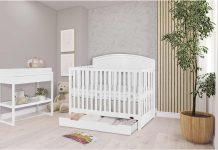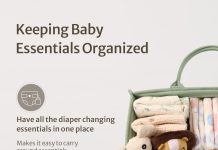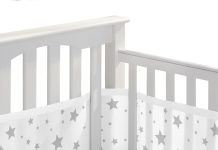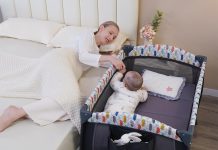When it comes to choosing the perfect crib for your little one, buying a used one can be a great money-saving option. However, it’s essential to ensure that the crib is safe and in good condition before bringing it home. In this article, we will provide you with a comprehensive list of questions that you should ask when buying a used crib, helping you make the best decision for your baby’s safety and comfort.
Review contents
General Safety
Has the crib been recalled?
When buying a used crib, it is crucial to inquire whether the crib has ever been recalled. Recalls happen when cribs are found to have design flaws or safety issues that could potentially harm infants. By ensuring that the crib has not been recalled, we can be confident in the safety of our little one.
Is the crib certified by relevant safety standards?
Checking if the crib is certified by relevant safety standards provides reassurance that the crib meets the necessary safety requirements. It is essential to look for certifications such as the Juvenile Products Manufacturers Association (JPMA) certification seal, as it guarantees that the crib has undergone rigorous testing and meets safety standards.
Are all the parts intact and securely attached?
Examining if all parts of the crib are intact and securely attached ensures that there are no missing or loose pieces that could pose a hazard to our baby. Loose or missing parts could compromise the stability of the crib and potentially lead to accidents or injuries.
Has the crib been repaired or modified?
We should inquire about any repairs or modifications made to the crib. Repairs done by a reputable professional can be safe, but it is important to assess whether the repairs have been carried out properly and do not compromise the overall safety and stability of the crib.
Are the slats spaced appropriately?
It is crucial to check the spacing between the slats on the crib. The slats should be close enough to prevent a baby’s head from getting trapped between them. According to safety standards, the distance between slats should be no more than 2 ⅜ inches (about the width of a soda can) to ensure the safety of our little one.
Materials and Construction
What materials is the crib made of?
Knowing the materials used to construct the crib is essential for assessing its durability and safety. Cribs made from solid wood or metal tend to be sturdier than those made from particleboard or flimsy materials. Materials should also be free from any toxic substances or chemicals to ensure the well-being of our baby.
Is the crib sturdy and stable?
Ensuring the crib is sturdy and stable is crucial to provide a secure environment for our baby. We should check for any wobbling or weakness in the crib’s structure and ensure that it can safely withstand a baby’s movements.
Are the corners and edges smooth without sharp points?
Examining the corners and edges of the crib is important to avoid any potential injuries to our child. The corners should be smooth without any sharp points that could pose a risk of cuts or bruises.
Does the crib have any signs of wear or damage?
Inspecting the crib for any signs of wear or damage is vital to assess its overall condition. Look for any cracks, splinters, or peeling paint. Any damage to the crib could compromise its safety and durability.
Is the paint non-toxic and lead-free?
Confirming that the paint used on the crib is non-toxic and lead-free is crucial to protect our baby’s health. Lead-based paint can pose serious health risks, especially for young children who may chew on the crib railings. Opting for cribs with non-toxic finishes ensures a safe environment for our little one.
Mattress and Bedding
Does the crib come with a mattress?
Inquiring whether the crib comes with a mattress is essential to determine if we need to purchase one separately. A well-fitting mattress is crucial for our baby’s comfort and safety.
Is the mattress in good condition, firm, and fits snugly?
Checking the condition of the mattress is important to ensure it is still in good shape and provides adequate support for our baby. It should be firm and fit snugly within the crib to prevent any gaps where the baby could potentially get trapped.
Is the mattress waterproof or does it have a removable cover?
Having a waterproof mattress or a removable cover is beneficial for easy cleaning. Babies are prone to accidents, and being able to wipe off any spills or messes can save us time and effort in keeping the crib clean and hygienic.
Are there any bedding accessories included?
Inquiring about any bedding accessories included with the crib is helpful in assessing the overall value and convenience of the purchase. Accessories such as extra sheets, mattress pads, or crib bumpers can be a valuable addition to the crib.
Does the crib meet current safety standards for mattress and bedding?
Ensuring that the crib meets current safety standards for both the mattress and bedding is vital to provide a safe sleep environment for our baby. Standards evolve, and it is essential to confirm that the crib meets the latest guidelines to minimize the risk of accidents and promote safe sleep practices.
Assembly and Disassembly
Are the assembly instructions and necessary hardware available?
It is important to ensure that the crib comes with the necessary assembly instructions and all the required hardware. Having access to clear instructions makes the assembly process easier and minimizes the risk of improper set-up.
Has the crib ever been disassembled?
Knowing whether the crib has ever been disassembled helps in assessing its overall condition and potential wear and tear. Crib components can become loose or damaged during disassembly, therefore, it is important to ensure that all parts are still in good working condition.
Are there any difficulties in assembling or disassembling the crib?
Inquiring about any difficulties or complexities involved in assembling or disassembling the crib is helpful in understanding the level of effort required. Easy assembly and disassembly can be convenient, especially for families who frequently relocate or travel.
Does the crib come with additional features for easy assembly?
Some cribs may come with additional features that make assembly easier, such as quick-release mechanisms or tool-free assembly options. These features can save time and effort during the set-up process.
Age and Usage History
How old is the crib?
Knowing the age of the crib provides insight into its potential wear and tear. Older cribs may have been subject to outdated safety standards or may have experienced more usage, potentially affecting their overall safety and durability.
How many previous owners has the crib had?
Inquiring about the number of previous owners of the crib can provide a sense of its history. Understanding how many families have used the crib can help assess its quality and whether it has demonstrated durability over time.
Has the crib been used for multiple children?
Knowing if the crib has been used for multiple children can shed light on its durability and reliability. Cribs that have safely accommodated multiple children tend to demonstrate their resilience and quality.
Has the crib been stored properly when not in use?
It is important to inquire about how the crib has been stored when not in use. Proper storage, such as disassembling and storing in a dry and protected area, helps maintain the crib’s condition and ensures its reliability for future use.
Have there been any accidents or incidents involving the crib?
Inquiring about any accidents or incidents involving the crib is crucial for understanding its safety record. It is essential to know if there have been any structural failures or other issues that could compromise the well-being of our baby.
Conversion Options
Is the crib convertible into a toddler bed, daybed, or full-size bed?
Knowing if the crib is convertible can be advantageous in terms of long-term use and value for money. Convertible cribs can be transformed into different bed sizes, allowing the crib to adapt as our child grows.
Are the conversion kits included?
Inquiring whether the crib comes with the necessary conversion kits is important to assess additional costs. Conversion kits can be separate purchases and may impact the overall value and convenience of the crib.
Are there any specific requirements for conversion?
Checking for any specific requirements for crib conversion is essential to ensure a smooth transition. Some cribs may require additional hardware or modifications when converting, so it is important to be aware of these requirements.
Are the conversion mechanisms safe and functional?
It is paramount to verify the safety and functionality of the crib’s conversion mechanisms. Ensuring that the conversion features are in good working condition minimizes any risks and allows for easy transitioning between different bed sizes.
Does the manufacturer offer support for conversion options?
Checking if the manufacturer provides support for conversion options is important for any potential questions or concerns during the conversion process. Manufacturers’ support can offer guidance on proper installation and ensure a seamless transition for our baby.
Manufacturer Information
Who is the manufacturer of the crib?
Knowing the manufacturer of the crib provides insight into its reputation and quality. Well-established and reputable manufacturers often prioritize safety and quality in their designs.
Is the manufacturer reputable with good customer reviews?
Researching the manufacturer’s reputation and customer reviews can give an indication of their commitment to producing safe and reliable cribs. Positive customer reviews reflect customer satisfaction and confidence in the manufacturer’s products.
Does the manufacturer provide contact information or customer support?
Inquiring whether the manufacturer provides contact information or customer support is important for any potential questions or concerns regarding the crib. Having direct access to the manufacturer’s support ensures quick and reliable assistance, if needed.
Can replacement parts be easily obtained?
Ensuring that replacement parts for the crib are easily obtainable is crucial for maintaining its longevity and safety. Availability of replacement parts provides peace of mind that any necessary repairs or replacements can be made promptly, if required.
Is there any warranty or guarantee provided by the manufacturer?
Checking if the manufacturer offers any warranty or guarantee is beneficial in safeguarding our investment. A warranty or guarantee demonstrates the manufacturer’s confidence in their product and provides assurance in case of any unforeseen issues.
Certifications and Standards
Does the crib meet the current safety standards set by the Consumer Product Safety Commission (CPSC)?
Confirming that the crib meets the current safety standards set by the CPSC is essential for the well-being of our baby. Compliance with these standards ensures that the crib has undergone rigorous testing and meets the highest safety requirements.
Does it have the Juvenile Products Manufacturers Association (JPMA) certification seal?
The JPMA certification seal guarantees that the crib has met stringent safety standards established by industry experts. Cribs with the JPMA certification seal have undergone thorough testing, assuring us of their safety and quality.
Has the crib passed any additional safety tests or certifications?
Inquiring whether the crib has passed any additional safety tests or certifications provides further confirmation of its safety and quality. Additional certifications or testings indicate that the crib exceeds minimum safety requirements, providing an extra layer of peace of mind.
Does it comply with ASTM International standards?
Ensuring that the crib complies with ASTM International standards reaffirms its adherence to rigorous safety guidelines. ASTM International standards are globally recognized, emphasizing the crib’s commitment to meeting the highest safety requirements.
Is the crib approved for use in your country?
Verifying that the crib is approved for use in our country is crucial, as safety standards and regulations may vary across different regions. It is important to ensure that the crib adheres to the specific requirements of our country to guarantee our baby’s safety.
Price and Value
What is the asking price for the used crib?
Considering the asking price for the used crib allows us to assess its affordability and whether it fits within our budget. Comparing the price with new cribs of similar quality can provide insight into its value.
Is the price reasonable compared to new cribs of similar quality?
Evaluating whether the price is reasonable compared to new cribs of similar quality helps determine the value of the used crib. If the price is significantly lower than the new counterparts, it may indicate the need for closer inspection or questioning the condition.
Are there any additional costs or accessories included?
Inquiring about any additional costs or accessories included with the crib helps determine the overall value of the purchase. Additional accessories, such as a mattress or bedding items, can contribute to the convenience and practicality of the crib.
Is there room for negotiation on the price?
Exploring the possibility of negotiating the price allows for potential savings. While not all sellers may be open to negotiation, it is worth considering whether there is room for adjustment in the asking price.
Does the crib offer good value for the price?
Considering all factors, such as safety, quality, condition, and additional accessories, helps determine whether the crib offers good value for the asking price. A careful evaluation of these elements allows us to make an informed decision.
Selling and Return Policy
What is the seller’s return policy for the crib?
Understanding the seller’s return policy for the crib is important in case there are any unforeseen issues or if we change our mind about the purchase. Being aware of the return policy protects our interests as buyers.
Are there any restrictions or conditions for returning the crib?
Checking for any restrictions or conditions for returning the crib helps us understand the flexibility of the return policy. It is important to be aware of the timeline, possible fees, or specific requirements for returning the crib, if applicable.
Can you inspect the crib thoroughly before making the purchase?
Ensuring that we have the opportunity to thoroughly inspect the crib before finalizing the purchase is crucial. Being able to scrutinize the crib’s condition in person allows us to make an informed decision and ensures that it meets our safety and quality standards.
What is the seller’s reputation and feedback from previous buyers?
Researching the seller’s reputation and feedback from previous buyers gives us an idea of their reliability and honesty. Positive feedback and a good reputation contribute to our confidence in the seller and the quality of the crib they are offering.
Is the seller willing to provide any additional information or photos of the crib?
Requesting additional information or photos of the crib from the seller can help us make a more informed decision. Clear and detailed documentation allows for a better understanding of the crib’s condition, potential flaws, or any specific features we may be interested in.
By asking these questions when buying a used crib, we can ensure that we are making a safe and informed decision for our little one. Taking the time to thoroughly inspect the crib, research the manufacturer, and consider safety standards and certifications will provide peace of mind as we create a nurturing and secure environment for our baby. Remember, safety should always be the top priority when choosing a crib, whether new or used.






























